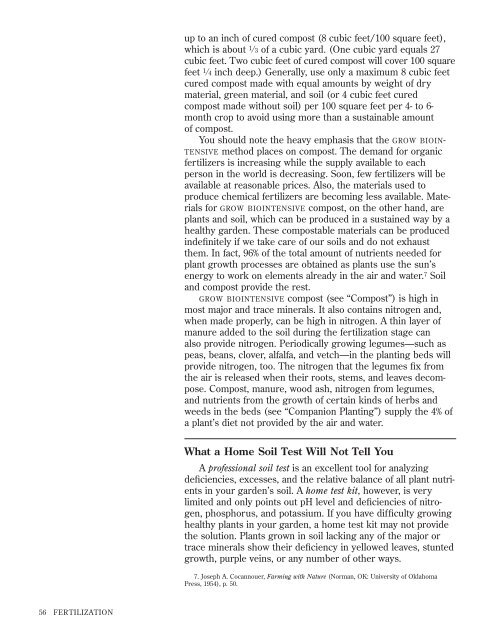How to Grow More Vegetables : And Fruits, Nuts ... - Shroomery
How to Grow More Vegetables : And Fruits, Nuts ... - Shroomery
How to Grow More Vegetables : And Fruits, Nuts ... - Shroomery
You also want an ePaper? Increase the reach of your titles
YUMPU automatically turns print PDFs into web optimized ePapers that Google loves.
56 FERTILIZATION<br />
up <strong>to</strong> an inch of cured compost (8 cubic feet/100 square feet),<br />
which is about 1 ⁄ 3 of a cubic yard. (One cubic yard equals 27<br />
cubic feet. Two cubic feet of cured compost will cover 100 square<br />
feet 1 ⁄ 4 inch deep.) Generally, use only a maximum 8 cubic feet<br />
cured compost made with equal amounts by weight of dry<br />
material, green material, and soil (or 4 cubic feet cured<br />
compost made without soil) per 100 square feet per 4- <strong>to</strong> 6month<br />
crop <strong>to</strong> avoid using more than a sustainable amount<br />
of compost.<br />
You should note the heavy emphasis that the GROW BIOIN-<br />
TENSIVE method places on compost. The demand for organic<br />
fertilizers is increasing while the supply available <strong>to</strong> each<br />
person in the world is decreasing. Soon, few fertilizers will be<br />
available at reasonable prices. Also, the materials used <strong>to</strong><br />
produce chemical fertilizers are becoming less available. Materials<br />
for GROW BIOINTENSIVE compost, on the other hand, are<br />
plants and soil, which can be produced in a sustained way by a<br />
healthy garden. These compostable materials can be produced<br />
indefinitely if we take care of our soils and do not exhaust<br />
them. In fact, 96% of the <strong>to</strong>tal amount of nutrients needed for<br />
plant growth processes are obtained as plants use the sun’s<br />
energy <strong>to</strong> work on elements already in the air and water. 7 Soil<br />
and compost provide the rest.<br />
GROW BIOINTENSIVE compost (see “Compost”) is high in<br />
most major and trace minerals. It also contains nitrogen and,<br />
when made properly, can be high in nitrogen. A thin layer of<br />
manure added <strong>to</strong> the soil during the fertilization stage can<br />
also provide nitrogen. Periodically growing legumes—such as<br />
peas, beans, clover, alfalfa, and vetch—in the planting beds will<br />
provide nitrogen, <strong>to</strong>o. The nitrogen that the legumes fix from<br />
the air is released when their roots, stems, and leaves decompose.<br />
Compost, manure, wood ash, nitrogen from legumes,<br />
and nutrients from the growth of certain kinds of herbs and<br />
weeds in the beds (see “Companion Planting”) supply the 4% of<br />
a plant’s diet not provided by the air and water.<br />
What a Home Soil Test Will Not Tell You<br />
A professional soil test is an excellent <strong>to</strong>ol for analyzing<br />
deficiencies, excesses, and the relative balance of all plant nutrients<br />
in your garden’s soil. A home test kit, however, is very<br />
limited and only points out pH level and deficiencies of nitrogen,<br />
phosphorus, and potassium. If you have difficulty growing<br />
healthy plants in your garden, a home test kit may not provide<br />
the solution. Plants grown in soil lacking any of the major or<br />
trace minerals show their deficiency in yellowed leaves, stunted<br />
growth, purple veins, or any number of other ways.<br />
7. Joseph A. Cocannouer, Farming with Nature (Norman, OK: University of Oklahoma<br />
Press, 1954), p. 50.












